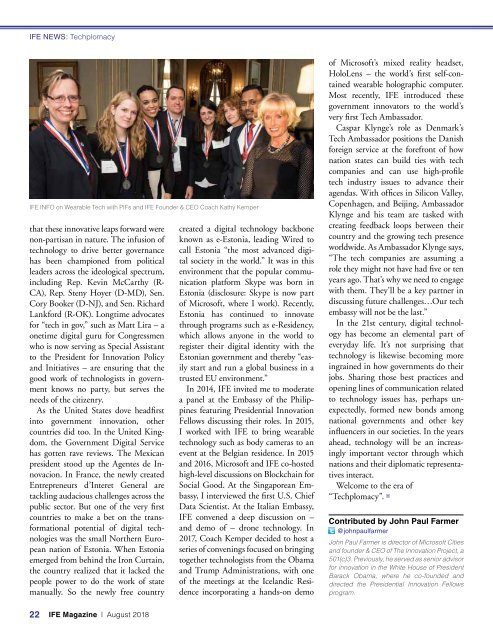IFE Magazine
Read through the first issue of IFE Magazine, which embodies Institute for Education's activity in the first six months of 2018. IFE’s mission is to harness the power of data, innovation, soft diplomacy and technology.
Read through the first issue of IFE Magazine, which embodies Institute for Education's activity in the first six months of 2018. IFE’s mission is to harness the power of data, innovation, soft diplomacy and technology.
Create successful ePaper yourself
Turn your PDF publications into a flip-book with our unique Google optimized e-Paper software.
<strong>IFE</strong> NEWS: Techplomacy<br />
<strong>IFE</strong> INFO on Wearable Tech with PIFs and <strong>IFE</strong> Founder & CEO Coach Kathy Kemper<br />
that these innovative leaps forward were<br />
non-partisan in nature. The infusion of<br />
technology to drive better governance<br />
has been championed from political<br />
leaders across the ideological spectrum,<br />
including Rep. Kevin McCarthy (R-<br />
CA), Rep. Steny Hoyer (D-MD), Sen.<br />
Cory Booker (D-NJ), and Sen. Richard<br />
Lankford (R-OK). Longtime advocates<br />
for “tech in gov,” such as Matt Lira – a<br />
onetime digital guru for Congressmen<br />
who is now serving as Special Assistant<br />
to the President for Innovation Policy<br />
and Initiatives – are ensuring that the<br />
good work of technologists in government<br />
knows no party, but serves the<br />
needs of the citizenry.<br />
As the United States dove headfirst<br />
into government innovation, other<br />
countries did too. In the United Kingdom,<br />
the Government Digital Service<br />
has gotten rave reviews. The Mexican<br />
president stood up the Agentes de Innovacion.<br />
In France, the newly created<br />
Entrepreneurs d’Interet General are<br />
tackling audacious challenges across the<br />
public sector. But one of the very first<br />
countries to make a bet on the transformational<br />
potential of digital technologies<br />
was the small Northern European<br />
nation of Estonia. When Estonia<br />
emerged from behind the Iron Curtain,<br />
the country realized that it lacked the<br />
people power to do the work of state<br />
manually. So the newly free country<br />
created a digital technology backbone<br />
known as e-Estonia, leading Wired to<br />
call Estonia “the most advanced digital<br />
society in the world.” It was in this<br />
environment that the popular communication<br />
platform Skype was born in<br />
Estonia (disclosure: Skype is now part<br />
of Microsoft, where I work). Recently,<br />
Estonia has continued to innovate<br />
through programs such as e-Residency,<br />
which allows anyone in the world to<br />
register their digital identity with the<br />
Estonian government and thereby “easily<br />
start and run a global business in a<br />
trusted EU environment.”<br />
In 2014, <strong>IFE</strong> invited me to moderate<br />
a panel at the Embassy of the Philippines<br />
featuring Presidential Innovation<br />
Fellows discussing their roles. In 2015,<br />
I worked with <strong>IFE</strong> to bring wearable<br />
technology such as body cameras to an<br />
event at the Belgian residence. In 2015<br />
and 2016, Microsoft and <strong>IFE</strong> co-hosted<br />
high-level discussions on Blockchain for<br />
Social Good. At the Singaporean Embassy,<br />
I interviewed the first U.S. Chief<br />
Data Scientist. At the Italian Embassy,<br />
<strong>IFE</strong> convened a deep discussion on –<br />
and demo of – drone technology. In<br />
2017, Coach Kemper decided to host a<br />
series of convenings focused on bringing<br />
together technologists from the Obama<br />
and Trump Administrations, with one<br />
of the meetings at the Icelandic Residence<br />
incorporating a hands-on demo<br />
of Microsoft’s mixed reality headset,<br />
HoloLens – the world’s first self-contained<br />
wearable holographic computer.<br />
Most recently, <strong>IFE</strong> introduced these<br />
government innovators to the world’s<br />
very first Tech Ambassador.<br />
Caspar Klynge’s role as Denmark’s<br />
Tech Ambassador positions the Danish<br />
foreign service at the forefront of how<br />
nation states can build ties with tech<br />
companies and can use high-profile<br />
tech industry issues to advance their<br />
agendas. With offices in Silicon Valley,<br />
Copenhagen, and Beijing, Ambassador<br />
Klynge and his team are tasked with<br />
creating feedback loops between their<br />
country and the growing tech presence<br />
worldwide. As Ambassador Klynge says,<br />
“The tech companies are assuming a<br />
role they might not have had five or ten<br />
years ago. That’s why we need to engage<br />
with them. They’ll be a key partner in<br />
discussing future challenges…Our tech<br />
embassy will not be the last.”<br />
In the 21st century, digital technology<br />
has become an elemental part of<br />
everyday life. It’s not surprising that<br />
technology is likewise becoming more<br />
ingrained in how governments do their<br />
jobs. Sharing those best practices and<br />
opening lines of communication related<br />
to technology issues has, perhaps unexpectedly,<br />
formed new bonds among<br />
national governments and other key<br />
influencers in our societies. In the years<br />
ahead, technology will be an increasingly<br />
important vector through which<br />
nations and their diplomatic representatives<br />
interact.<br />
Welcome to the era of<br />
“Techplomacy”. U<br />
Contributed by John Paul Farmer<br />
@johnpaulfarmer<br />
John Paul Farmer is director of Microsoft Cities<br />
and founder & CEO of The Innovation Project, a<br />
501(c)3. Previously, he served as senior advisor<br />
for innovation in the White House of President<br />
Barack Obama, where he co-founded and<br />
directed the Presidential Innovation Fellows<br />
program.<br />
22 <strong>IFE</strong> <strong>Magazine</strong> | August 2018


